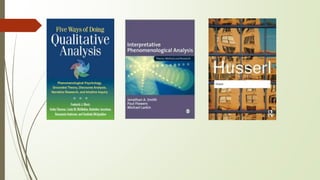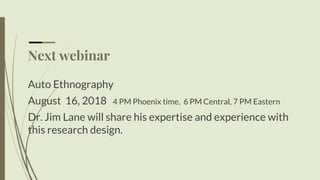This document provides an overview of phenomenology as a research method. It discusses the two main types of phenomenology: transcendental/descriptive phenomenology developed by Husserl which aims to describe the essence of a phenomenon, and hermeneutic phenomenology developed by Heidegger which acknowledges the interpretive nature of understanding a phenomenon. The document outlines key concepts in phenomenology like epoché, horizontalization, and eidetic variation. It then discusses hermeneutic phenomenological research methods and provides examples of potential research problems, purposes, questions, and topics. Finally, it briefly introduces transcendental phenomenology and provides additional examples.





![Introduction to Phenomenology
• German philosophical roots
• Husserl
• Looking at consciousness, intentionality of consciousness in the world, difference of
actual ‘thing’ in the world and our understanding of that ‘thing’
• Can only experience our conscious experience of the ‘thing’
• Can we get to the core essence of what that ‘thing’ is?
• Heidegger
• Followed Husserl, but offered a challenge in that there is a layer of interpretation of
the ‘thing’
• Can not get at core essence due to our lenses (culture, language, etc.) or ‘thrownness’
• Into research methods
• A. Giorgi - brought Husserlian phenomenology into research in the West - called ‘pure’,
descriptive or transcendental phenomenology, among other things (Husserl [G], Merleau-
Ponty, Sartre[F])
• Objective stance, full bracketing, can get at the essence of the ‘thing’ itself](https://image.slidesharecdn.com/phenomenology-221208134440-d8141a09/85/phenomenology-pptx-6-320.jpg)
![Terms
Phenomenological Reduction: [related to epoché - process of epoché leads to
phenom. reduction] “the term for our thematization of the correlation between
subjectivity and world (Zahavi 2003)” (Davidsen, 2013)
Epoché: “suspend our acceptance of the natural attitude and bracket its validity”
(Davidsen, 2013) [Bracketing] (one area of much debate)
Horizontalization: “trying to understand all phenomena at the same level by not
prioritizing phenomena (Langdridge 2007)”
Eidetic variation: “attempting to imagine the object being different from how it
currently is (Zahavi 2003)”
Synthesizing: bringing the descriptions, conclusions all together (van Manen, 2016)](https://image.slidesharecdn.com/phenomenology-221208134440-d8141a09/85/phenomenology-pptx-7-320.jpg)




















